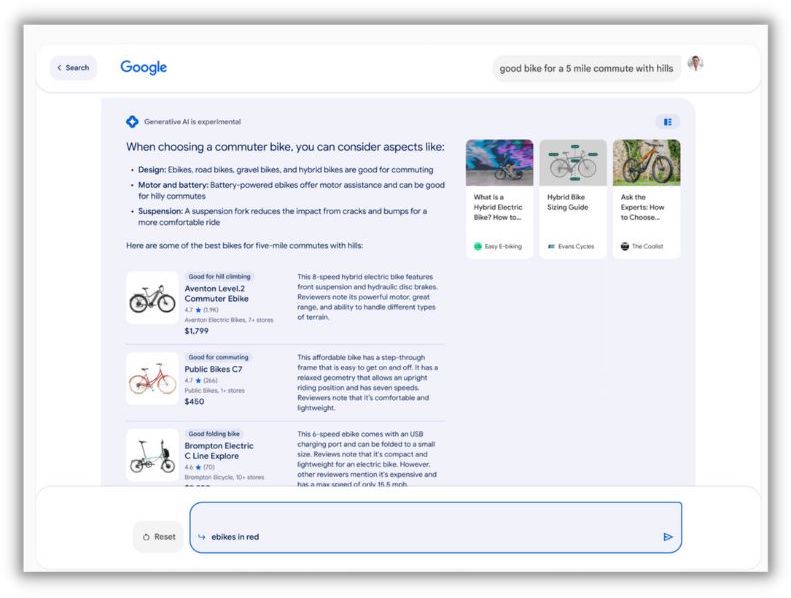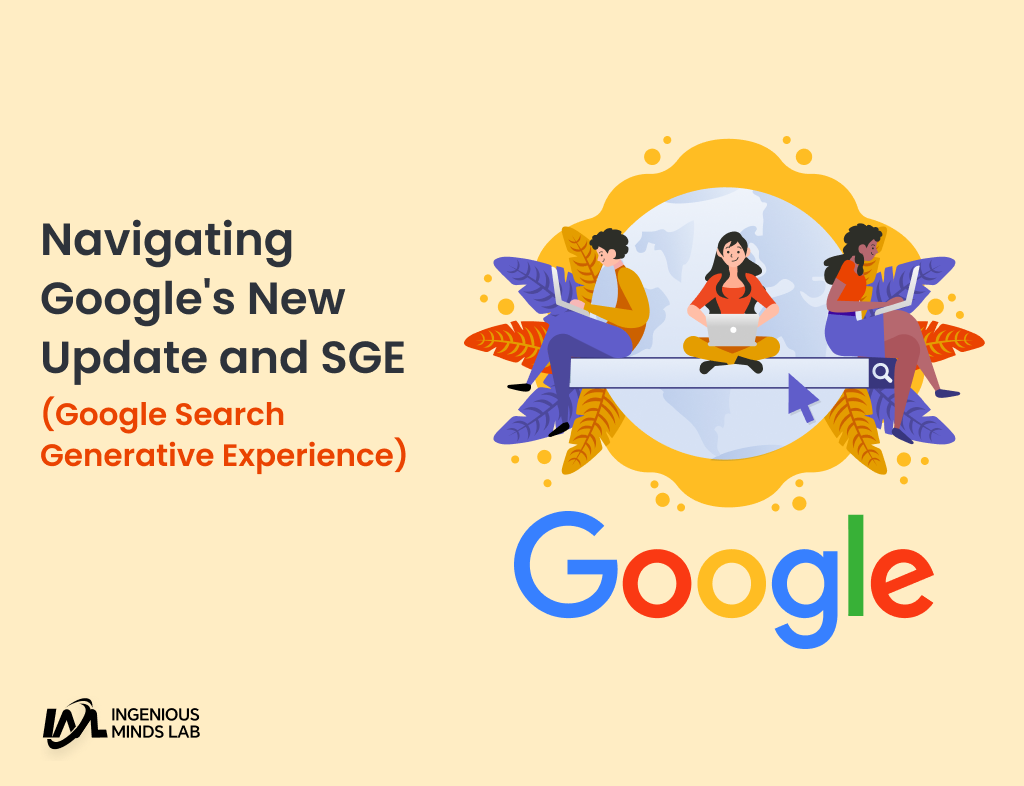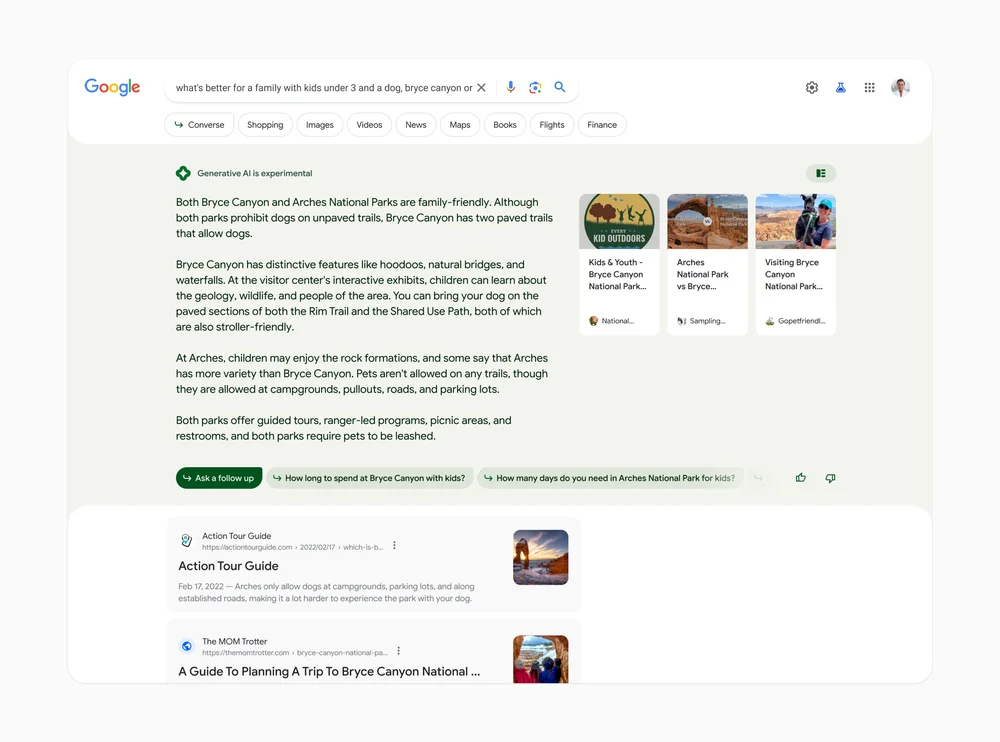In the world of search engine optimization (SEO), staying on top of the latest developments and updates is essential to maintaining a competitive edge. In this blog we will Navigating Google’s New Update and SGE for SEO Success. Recently, Google introduced a groundbreaking update that has revolutionized the way search results are presented: Search Generated Entities (SGE). Coupled with the power of AI-generated content, SGE has reshaped the SEO landscape and opened up new avenues for website owners and digital marketers.
Google’s new update, centered around SGE, aims to enhance the user experience by providing direct answers and relevant information right on the search engine results page (SERP). Instead of relying solely on traditional blue links to web pages, Google now generates entities and displays them in featured snippets, knowledge panels, and other rich elements. This shift has significant implications for businesses seeking to optimize their online presence and improve organic search rankings.
SGE represents the culmination of Google’s advancements in artificial intelligence and machine learning. Through sophisticated algorithms, Google analyzes user queries and extracts relevant information from trusted sources to present concise answers and summaries. This approach allows users to obtain the information they seek without the need to click through to external websites.
As a website owner or digital marketer, understanding SGE and its impact on SEO is paramount to driving targeted traffic and increasing visibility. While SGE offers new opportunities to capture users’ attention, it also poses challenges in terms of adapting content strategies and vying for inclusion in featured snippets.
In this comprehensive guide, we will delve deep into the world of AI-generated content and explore how it intersects with Google’s new update and SGE. We will uncover strategies and best practices for leveraging AI-driven approaches to enhance organic search rankings and navigate the evolving SEO landscape successfully.
Join us on this journey as we unlock the power of AI-generated content, unravel the intricacies of Google’s new update, and discover how SGE can propel your website to SEO success. Let’s harness the potential of AI and SGE to elevate your online presence and stay ahead of the curve in the ever-evolving world of search engine optimization.
What Is Google’s New Update and SGE
In the realm of search engine optimization (SEO), one concept that has gained prominence in recent times is Search Generated Entities (SGE). SGE refers to the entities or topics that are generated by search engines in response to user queries. It involves the extraction and display of relevant information directly on the search engine results page (SERP), providing users with quick answers and reducing the need to click through to external websites.
SGE represents a shift in how search engines present information to users. Traditionally, search engines would display a list of blue links to web pages that might contain the desired information. However, with the advent of SGE, search engines now aim to directly answer user queries by displaying relevant information in featured snippets, knowledge panels, and other rich elements on the SERP.
These search-generated entities are often generated using AI and machine learning algorithms that analyze vast amounts of data to understand user intent and deliver precise and concise information. SGE can take various forms, including summaries, definitions, tables, charts, and even interactive elements like calculators or maps.
One common example of SGE is the featured snippet, also known as position zero, which appears prominently at the top of the search results. It provides a concise answer to a user’s query extracted from a relevant web page. The goal of SGE is to provide users with immediate and helpful information, reducing the need for them to click through to external websites for answers.
While SGE has undoubtedly improved the search experience for users, it has also posed challenges for website owners and SEO professionals. With the increased prominence of SGE, organic search results may be pushed further down the page, impacting the visibility and click-through rates of traditional search results. This shift has prompted website owners to adapt their SEO strategies to optimize for SGE and strive for inclusion in these featured snippets and knowledge panels.
Understanding SGE and its impact on SEO is crucial for businesses and website owners. It presents both opportunities and challenges. On one hand, being featured in SGE can drive significant traffic and visibility to your website. On the other hand, it may reduce the reliance on organic search results, requiring businesses to adjust their content strategies to align with the evolving search landscape.
In the next sections, we will delve deeper into the strategies and best practices for optimizing content for SGE and maximizing its potential to enhance your SEO success. We will explore how AI-generated content can play a role in aligning with SGE and provide insights into staying ahead in the ever-changing SEO landscape.
AI Snapshot, Conversational Mode, and Vertical Experiences: Enhancing User Engagement and Search Relevance
In addition to Google’s new update and SGE, there are other innovative features that have emerged to transform the search experience. AI Snapshot, Conversational Mode, and Vertical Experiences are three key elements that further enhance user engagement and search relevance. Let’s explore each of them in more detail:
- AI Snapshot: AI Snapshot refers to the ability of search engines to provide quick, concise answers to user queries directly on the search results page. Leveraging AI technology, search engines like Google can generate snippets of information, often in the form of featured snippets or knowledge panels, that provide users with immediate answers to their questions. This feature saves users time and effort by eliminating the need to click through to websites for basic information. As a website owner, understanding how to optimize your content to be featured in AI snapshots can significantly improve your visibility and drive more organic traffic.
- Conversational Mode: Conversational Mode represents a shift towards more natural language interactions with search engines. Traditionally, search queries consisted of a few keywords or phrases. However, with the advancement of AI and voice search technology, users are now able to perform searches using more conversational language, similar to how they would ask a question in a conversation. This has led to the rise of voice assistants like Siri, Alexa, and Google Assistant, which are designed to understand and respond to conversational queries. As a result, website owners and marketers need to optimize their content to align with conversational search patterns, ensuring that their websites appear in voice search results and conversational AI interactions.

Conversational Mode | Navigating Google’s New Update and SGE for SEO Success - Vertical Experiences: Vertical Experiences refer to search engines’ efforts to provide specialized and targeted search results tailored to specific industries or topics. Instead of generic search results, vertical experiences offer users more focused and relevant information within specific niches such as travel, health, finance, and more. These verticals often include additional features like interactive maps, image carousels, reviews, and specific filters that cater to the unique needs of users within those domains. Optimizing your website for vertical experiences involves understanding the requirements and expectations of the particular industry or topic you operate in, ensuring your content aligns with the specific vertical search criteria, and providing a seamless user experience within that vertical.

Vertical Experiences | Navigating Google’s New Update and SGE for SEO Success
By embracing AI Snapshot, Conversational Mode, and Vertical Experiences, website owners and digital marketers can enhance their engagement with users, deliver more relevant search results, and increase the visibility of their content. It is crucial to adapt your SEO strategies to accommodate these evolving features and ensure that your website remains competitive in the ever-changing digital landscape.
In the following sections, we will explore practical tips and techniques to leverage AI-generated content, navigate Google’s new update and SGE, and optimize for AI Snapshot, Conversational Mode, and Vertical Experiences. Let’s dive in and unlock the full potential of these innovative search features for SEO success.
Understanding Google’s AI-Generated Content
Google’s AI-generated content refers to the use of advanced machine learning algorithms to generate text and answers to user queries. It aims to enhance the search experience by providing quick and accurate information directly on the search engine results page (SERP). The content generated by AI models, such as GPT-3, is designed to mimic human-like responses, making it difficult to differentiate between AI-generated and human-written content.
Exploring the Role of SGE
SGE, or Search Generated Entities, is a concept introduced by Google to describe instances where AI-generated content is displayed directly on the SERP, reducing the need for users to click through to websites. ID2 sheds light on the monetization aspect of search results, highlighting that a significant portion of Google’s revenue comes from search result ads and display network ads.
By displaying AI-generated content on the SERP, Google aims to satisfy user queries directly, leading to a potential decrease in organic traffic to websites. While this shift may impact website owners and publishers, it also presents an opportunity for businesses to optimize their content strategies to align with Google’s evolving search landscape.
The Limitations and Challenges of AI-generated Content
While AI-generated content brings forth numerous advantages, it is not without its limitations. ID3 underscores that AI models, such as SG (Snapshot Generator), may not provide responses for certain queries or topics where human expertise or a personalized touch is deemed necessary. Google acknowledges the limitations of large language models, including misinterpretations, biases, and hallucinations.
It is crucial for content creators and SEO professionals to understand these limitations and work alongside AI-generated content to provide unique value and human insights that AI may lack. This presents an opportunity to leverage AI technology as a tool rather than a replacement for human creativity and expertise.
The Future of SEO and Content Creation
As Google continues to refine its algorithms and AI models, the SEO landscape is evolving rapidly. The integration of AI-generated content and the rise of SGE pose both challenges and opportunities for content creators and website owners.
To adapt to these changes, it is essential to focus on a comprehensive SEO strategy that goes beyond traditional keyword optimization. Content creators should aim to provide exceptional value, unique perspectives, and in-depth analysis that cannot be easily replicated by AI. By delivering expertly crafted content, they can build trust, establish authority, and attract organic traffic.
Furthermore, SEO professionals should stay updated with Google’s guidelines and recommendations regarding AI-generated content. Understanding how AI models interpret and prioritize information can help optimize content for improved visibility in search results.
Embracing AI Technology in Content Creation
Rather than perceiving AI-generated content as a threat, content creators and SEO professionals can harness its potential to augment their efforts. By utilizing AI tools and platforms like Surfer for AI (mentioned in ID3), they can streamline content writing processes, The integration of AI technology in content creation offers numerous benefits. AI tools like Surfer for AI mentioned in ID3 provide content writers with valuable assistance throughout the writing process. These tools can generate article outlines, conduct research, perform fact-checking, and even optimize content for SEO purposes. By leveraging AI in these areas, content creators can save time and resources, allowing them to focus on the more creative aspects of their work.
Furthermore, AI-generated content can serve as a valuable starting point for content creators. AI models can provide insights, generate ideas, and offer data-driven suggestions, empowering content creators to craft high-quality and engaging articles. With AI as a collaborator, content creators can enhance their productivity and deliver content that resonates with their target audience.
The Importance of Adaptability and Continuous Learning
In the rapidly evolving landscape of AI-generated content, adaptability and continuous learning are crucial for content creators and SEO professionals. Keeping up with the latest advancements, understanding user behavior, and analyzing data are key to staying ahead of the competition.
Content creators should regularly analyze user intent and search trends to identify opportunities for creating unique and valuable content. By staying attuned to their audience’s needs and preferences, they can deliver content that surpasses the capabilities of AI-generated responses.
SEO professionals should also invest in ongoing learning and development. This includes staying updated with Google’s guidelines, exploring new SEO techniques, and understanding how AI models interpret and rank content. By adapting their strategies to align with the evolving SEO landscape, professionals can optimize their content for maximum visibility and organic traffic.
Balancing User Experience and SEO Optimization
While optimizing content for search engines is important, it should not come at the expense of the user experience. Google’s focus on AI-generated content and SGE emphasizes the importance of delivering immediate and relevant information to users. Content creators and SEO professionals must strike a balance between SEO optimization and creating content that engages and satisfies users.
User-centric content that addresses their queries, provides valuable insights, and encourages interaction is more likely to attract and retain visitors. By prioritizing user experience alongside SEO best practices, content creators can build a loyal audience and establish their websites as authoritative sources of information.
The Ethical Considerations of AI-generated Content
As AI-generated content becomes more prevalent, ethical considerations come to the forefront. Transparency, accuracy, and accountability are crucial when utilizing AI models to generate content. Content creators and website owners must ensure that AI-generated content is clearly identified as such, avoiding any potential confusion or misrepresentation.
Additionally, content creators should remain vigilant about biases and potential pitfalls associated with AI-generated content. Regular manual reviews and fact-checking processes can help ensure the accuracy and reliability of the information presented to users.
Conclusion:
Google’s new update on AI-generated content and the rise of SGE are transforming the online landscape. Content creators and SEO professionals must adapt their strategies to leverage the potential of AI technology while providing unique value and human insights. By embracing AI tools, staying informed, and prioritizing user experience, they can navigate these changes successfully.
While AI-generated content offers efficiency and convenience, human creativity, expertise, and the ability to provide personalized insights remain invaluable. By combining the power of AI with human ingenuity, content creators can continue to deliver exceptional content that engages, informs, and resonates with their audience. The future of SEO and content creation lies in striking a harmonious balance between AI-generated content and human-driven expertise, shaping a more dynamic and enriched online experience for all


